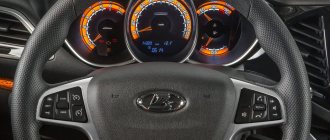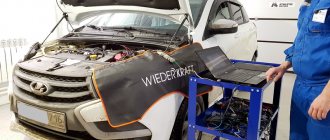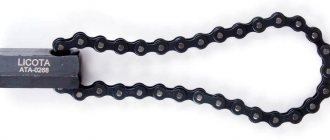From the very moment of the victory of capitalism in our country, the products of the Volzhsky Automobile Plant had a reputation for being very cheap, but unfinished cars. Or simply cars for the poor. VAZ small cars had a whole bunch of various shortcomings and were sold solely because of their bargain prices.
Naturally, this state of affairs could not exist forever; AvtoVAZ sank to the brink of bankruptcy. An alliance with the world-famous Renault-Nissan concern was supposed to save the situation. In 2012, an agreement was signed to create a joint production, which was intended to correct the situation.
AvtoVAZ immediately began assembling French cars under new names. For example, such as Lada Largus. But this was not exactly what millions of fans of Tolyatti cars were waiting for; a breakthrough model was needed that would be popular not only in Russia. This is exactly what Lada Vesta should have become. Or rather, a whole family of cars created on the basis of VAZ’s LADA XRAY concept.
Concept car LADA XRAY 2012
History of creation
I’ll start my review of the Lada Vesta with the history of its creation, which is very interesting.
In August 2012, the LADA XRAY Concept concept car was shown for the first time at the Moscow International Automobile Salon. The car was created by designer Steve Mattin. And it was on the basis of the ideas embedded in this car that a whole family of cars was created that were supposed to open a new era in the life of the Tolyatti auto giant.
One of the cars of this family was the Lada Vesta. The car is now available in two body styles: sedan and station wagon. The sedan car will be discussed in this article.
These cars are prominent representatives of one of the most popular class B cars in the world and in our country, according to the European classification, or simply Polo class. Vesta's main competitors are, respectively, Volkswagen Polo, Kia Rio, Hyundai Solaris and a huge army of Chinese B-class cars, to which Lada Vesta is very close in price.
Motors
The heart of any car is its engine. The Lada Vesta has two engines: 1.6 and 1.8 liters. VAZ engines, both petrol, according to the passport, have volumes of 1596 and 1774 cubic meters. see. These engines have a power of 106 and 122 hp, respectively. With these engines, the Lada Vesta accelerates to 100 km/h in 14.1 and 12.1 seconds, and accelerates, respectively, to 178 and 186 km/h .
Engine 21179. 1.8l. Photo - zr.ru
It is also worth noting that acceleration on Vesta, especially when equipped with a 1.8 liter engine and manual transmission, is powerful and smooth. But on cars with a robotic gearbox such reactions are not observed.
Fuel consumption is also quite decent. The 1.6 engine consumes 6.6 l/100 km in the combined cycle, and 1.8 – 7.2 liters. On the highway these figures are even lower, but in the city, naturally, they are higher, 9 and 9.3 liters per 100 km.
Transmission
At one time, the VAZ gearbox caused a lot of criticism. The same one that was installed on the “nines” and “tens”. Therefore, it was decided to abandon these boxes on new cars. Now Lada Vesta boasts a new five-speed manual transmission and, again, a five-speed robotic automatic transmission.
The manual transmission has definitely become much better than what it was and is in no way inferior in quality to the gearboxes of its competitors. But there were a lot of complaints about the robot. According to the first owners of Vesta, the gearbox is, frankly, stupid. I hope that Tolyatti residents will eliminate this problem in the future.
Chassis
The chassis is the pride of the Lada Vesta. Despite the fact that the technical components of the chassis are quite standard, with MacPherson struts at the front and semi-independent with a continuous beam at the rear, it is tuned simply superbly. During test drives of the Lada Vesta, journalists noted its incredible tuning, which makes driving a pleasure. According to testers, the chassis of the Lada Vesta is one of the best, if not the best, in the class.
New suspension
Now, after reviewing the technology of the car, we will review the exterior, and also take a detailed look at the interior of the Lada Vesta.
Side view of Lada Vesta
When creating the side design for the 2022 Lada Vesta, the chief designer managed to outdo the most talented employees of large companies. I have never seen such arcs and lines on the sides. For example, the wheel arches received fashionable semicircles, and boomerang-shaped lines were drawn above them. All this presses a little on the doors and greatly complements the appearance of the car.
The doors received oval and smooth edges. The door windows are shaped like a crown. The side mirrors have acquired a more compact shape compared to the Priora. If you look from the side, you will never guess that this is a creation born in Russia. Without the Volzhsky Concern logo, the car is in no way similar to previous creations.
From behind, the Lada Vesta 2022 2022 still looks attractive. A special role in shaping the overall impression is played by the taillights, made in accordance with all the rules of modern customer requirements. They somehow reminded me of the headlights of previous versions of the BMW 7 Series, although I could be wrong.
Steering
This is another strong trump card of the Tolyatti small car. Vesta can really be proud of its steering. You probably won’t find such precise reactions to changes in the position of the steering wheel in any of the potential competitors.
As for technology, the steering mechanism on the Lada Vesta is rack and pinion, equipped with a French-developed electric booster.
In addition, an important aspect that increases comfort is the ability to adjust the steering wheel in length and height, which has also never been seen on domestic cars before.
Impressive appearance
When you first look at the 2022 Lada Vesta, you get the impression that this is a Korean car. The design closely follows the lines of Hyundai models. And this is good news, since Russian cars will now also look attractive.
In front, a massive radiator grille stands out, where the logo of the Volzhsky manufacturer was placed. It is made in the shape of the letter “X”, recalling that this is a direct relative of the future Lada X Ray. High-quality light optics were attached to the sides of the grille, which partially extend onto the hood of the sedan. Below there are fog lights, and between them there is an air intake, below which there is a pointed bumper. Vesta's hood received dissecting lines, giving the car's appearance an aggressive look. Perhaps this is what could save Granta 2022 sales. You look at all this with great interest and with an even greater desire you want to touch the beauty. In the photo, the Lada Vesta 2022 of 2022 attracts the eye and makes you watch each design line for a long time.
Appearance
Briton Steve Mattin clearly worked with great inspiration on the appearance of the car. Vesta received a bright, unique design. The front of the car, made in X-style, looks especially striking. The sides of the car are also made in this style.
Among the external elements, the Lada Vesta mirrors with LED turn indicators integrated into them look very modern.
Mirrors with LED repeaters
15-inch tires look very natural on Vesta. With such “bast shoes” the car looks like a full-fledged golf-class car, or at least much more expensive than it actually is.
Review of the Lada Vesta sedan body
Lada Vesta attracts the eye very well and is perfectly memorable.
A distinctive feature of the Lada is the letter X on the side. Vesta looks gorgeous from all angles! Every centimeter of the body is worked out to the smallest detail. Of course, this car can be considered the most beautiful of the VAZ series. LADA is written in large letters on the trunk, which is very similar to the Volvo style. It matches the style of the model perfectly. On the front of the radiator grille there is a large image with a boat, showing that this is not a foreign car, but a domestic one.
The taillights are not LED, but still look very nice and modern. At the bottom of the rear bumper there is a fog lamp and a parking sensor. Vesta's luggage compartment volume is four hundred and eighty liters. It can be made larger by folding the rear seats. The gas tank cap seems very bulky and has received a lot of criticism about this. Gasoline in the Lada Vesta is filled with AI - ninety-five, or AI - ninety-eight.
Opening and closing doors is easy; you no longer have to slam as hard as you can to get the door to close. The developers placed the turn indicators on the side mirrors, which is much more reliable and looks more attractive. Vesta comes from the factory with sixteenth-radius alloy wheels and Matador tires (195/55). Front brakes are disc, rear drum. Braking is very effective because Vesta has an anti-lock braking system.
Interior
Despite the fact that the interior of the Lada Vesta is not such a strong part of the car as, for example, the chassis, there was still a real breakthrough for domestic cars here. The interior materials, although not the most expensive, look good. Everything is adjusted to the level of competitors, the design looks very fresh and interesting. How much does an X-shaped multimedia system cost...
The interior of the Lada Vesta is made of high-quality materials, however, in the first cars you can notice an insufficiently high-quality fit of plastic panels and small burrs. But I am sure that these problems will be eliminated in the future.
The interior will be to the liking of many
Despite the fact that the car is a representative of the B-class, the interior is very spacious (B+?). You won’t find such space even in many higher-end golf cars.
Passengers will especially appreciate the rear seat. Even three passengers with a height of 190 cm can comfortably sit here, without their heads resting on the ceiling.
Like most modern cars, Vesta’s sofa can be folded out in different proportions, which creates additional space for transporting large cargo. It should be noted that the rear sofas on Vesta are made quite rigid, from high-quality materials, which is also a big competitive advantage.
Impressive rear row of seats
The scale wells on the dashboard look very interesting. It is in this style that dashboards on modern, serious cars are made today. However, despite the interesting appearance, this dashboard design is criticized by most observers. Those who have had time to drive a Vesta write that the scales are hard to read and VAZ engineers did not finalize something in this direction.
Exterior of Vesta
The exterior design of the Lada Vesta is the merit of the Englishman Stephen Mattin. It was he who created the unique style for Vesta and X-Ray - and many domestic drivers hope that it will be he who will visually design the bodies of all new AvtoVAZ cars.
The exterior of the model is beyond praise. The almost faceless Kalina, Priora and Granta, comparable in body aesthetics only to the first Logan, which had not yet undergone restyling, cannot be compared with Vesta. Moreover, Lada Vesta outperforms many of its direct competitors precisely because of its appearance. For example, the Kia Rio, which has the same smoothness and roundness of shape, but lacks such precise masterful processing.
The main “calling card” of the Lada Vesta (as can be seen in the video) is the stamping on the front and rear wings. It forms sharp angles that close towards the central door pillar, which give critics the impression of an “X” stretched out to the sides. The embossed body made the car recognizable long before the start of mass production. Fortunately for Vesta connoisseurs, although the production model was significantly changed relative to the concept presented at the exhibition, the stamping still remained.
The trunk of Vesta is made roundly - without chopped sharp corners, thanks to which the stern harmonizes well with the front of the car. I was also pleased with the “front part” - a large radiator grille with a complex pattern, elegant elongated optics - all this creates a rather aggressive and sporty image for Vesta (which is especially appreciated by tuning enthusiasts).
The car is not only beautiful. Many people asked the same question on the forums: is the body of the Lada Vesta galvanized? The answer is yes: a corrosion-free guarantee of up to six years.
Options
An integral part of the increased level of comfort are the options available on Vesta. In my opinion, the number of options is unprecedented for the domestic auto industry. They match those of the best competing cars.
First of all, in Vesta, in addition to the traditional and familiar air conditioner, you can install climate control. True, all the delights of the climate control system will be appreciated only by the front passengers; air flows are not supplied separately to the rear seats of the Lada Vesta. There are simply no deflectors at the back (except at the feet).
Owners will also be pleased with the multimedia system with a 7″ display and TouchScreen. This MMC provides Bluetooth support, as well as HandsFree mode. Multimedia allows you to display on the screen an image from a camera installed at the rear of the car.
Rear view camera operation
True, such a system is available only on cars of rich configurations, as well as its controls on the steering wheel.
By the way, the steering wheels on this car are available in two versions. On the basic versions you will not get the multifunction steering wheel described above; you will get a regular steering column. But what cannot be taken away from her is that she will be very beautiful.
For the first time on a Lada - multifunction steering wheel
The multifunction steering wheel also contains keys for cruise control. This option, although it was already presented earlier on Priors, Kalinas and Grants, still came in handy here.
One of the same new options for domestic cars is a rain sensor. But alas, for the Lada Vesta it will not be available in basic trim levels. But the database includes electric windows for the front doors. The rear ones can also be installed, but for an additional fee.
Additional equipment Lada Vesta
In Lada Vesta, even in the basic version, there is an ERA - GLONASS system, which automatically determines the coordinates of a traffic accident and sends them to the rescue service.
A cool multimedia system that allows you to listen to the radio, connect various devices using a USB input, and some SD cards. The standard speakers have quite high-quality sound.
Resource
Many will say that you are going to write about a resource, because Vesta is a new car, and now there are simply no such cars with high mileage. In principle, those who say this will be right, but only partly. Autoreview journalists have already conducted a long test of the Lada Vesta. And we got very interesting results.
First of all, I’ll tell you about the method by which the test drive was carried out. Lada Vesta traveled 33,000 kilometers along the Dmitrovsky training ground on a variety of roads. For this mileage, one kilometer was counted as three. That is, Vesta has covered, as it were, 100,000 km. At the same time, the car regularly visited a salt fog chamber where body corrosion was simulated.
Part 1.
Part 2.
What can we say? The car passed this test with honor. First of all, it showed the incredible resistance of the body to corrosion - at the level of galvanized bodies.
Both the engine and the chassis worked through the heavy test drive of the Lada Vesta without any problems at all, which is also surprising.
The only weak point that the resource test revealed is the exhaust system. The fastening rubber bands kept breaking, and then the corrugation broke. These problems were pointed out to AvtoVAZ engineers and they promised to fix them.
Test drive Lada Vesta with manual transmission
Details Category: Test drive Published 12/27/2015
Yesterday a presentation of the Lada Vesta took place in Naberezhnye Chelny. We took the first test drive of a Lada Vesta with manual transmission . More on impressions below.
Let us remind you that we recently talked about our emotions after a test drive of a Lada Vesta with a “robot” in Kazan. Yesterday we visited the Auto-1 car showroom, where a presentation of the new product took place in Naberezhnye Chelny. During the presentation, a recording was made for a test drive of a Lada Vesta with a manual transmission . Of course, we couldn’t miss the opportunity to compare the Lada Vesta with a “robot” and a manual transmission.
We had to ride this white beauty.
Compared to other test cars, Lada Vesta looks special.
A short paperwork procedure and we go for a test drive.
We have already talked in detail about the convenience and settings of the workplace while driving Vesta.
This time we got a car in the “Comfort” configuration - this is an average configuration: without a rear view camera, touch monitor and other options.
The car is equipped with a 1.6 liter VAZ engine with a power of 106 hp. It is paired with a new five-speed manual transmission, created by AVTOVAZ in partnership with the Renault-Nissan alliance.
After warming up the car a little, we set off for the trip.
What can we say about the “mechanics” on Vesta ? It is qualitatively different from everything that was previously on Lada cars. The lever strokes are not very short, but clear. The lever itself fits comfortably in the hand.
Vesta uses a cable-driven gearbox. You will say that cable-driven gearboxes have long been installed on the same Kalinas and Grants. Yes, but even compared to them, the “mechanics” on the Vesta are clearer, and the gear shifts are smoother.
But the most pleasant difference between the “mechanics” on the Lada Vesta is the sound. Or rather, its absence. Anyone who has driven a Lada car at least a little probably cannot forget these transmission sounds - hum and howl, especially in 2nd gear.
Subconsciously, we expected the same from Vesta. Fortunately, we were wrong. Even when switching from 3rd to 2nd gear with a shift, the box does not make any sounds when releasing the clutch. And the engine noise does not bother the driver and passengers. All this completely erases from your mind the idea that you are driving a domestic car.
By the way, the clutch drive here is also different from the traditional one on VAZ front-wheel drive cars. There is no longer a cable drive, but a hydraulic clutch drive. The pedal has a fairly long stroke and allows you to handle it quite casually - the car still moves off smoothly and without jerking. Again, let's remember the owners of Kalin, Prior and Grant. Remember that annoying clicking sound when you release the clutch pedal? This is how the clutch cable tensioner mechanism installed on the clutch pedal works. Since the clutch drive on Vesta is hydraulic, there is no cable, and therefore no clicking mechanism either. Another plus for acoustic comfort in the cabin.
As we expected, the “mechanics” on Vesta allow you to dose the thrust very accurately. It realizes the potential of the 106-horsepower engine much better than the “robot”. You can drive economically, shifting at medium engine speeds, or you can easily accelerate in 2nd gear to 60-70 km/h. Even with such acceleration, the sound of the engine entering the cabin is muffled—we give Vesta a solid “five” for the sound insulation of the engine compartment.
The anti-rollback protection system also showed itself to be excellent - when you engage a gear and release the brake pedal, the car is held motionless for another 2 seconds, which allows even inexperienced drivers to set off without rolling back.
Let's summarize. As we thought, the manual Lada Vesta more than the robotic one. It is both cheaper than the “robotic” version and more pleasant to operate.











